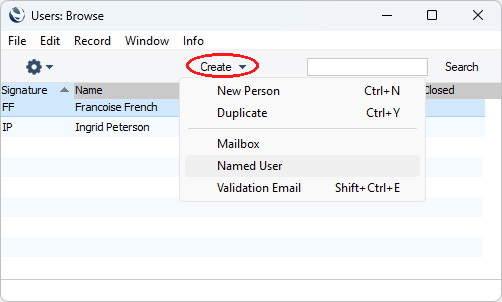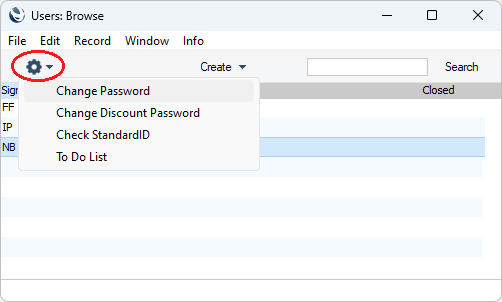User Accounts (Named Users and Concurrent Users with Mailboxes)
When you create a new Standard ERP database as described
here, you will create at least one User Account, consisting of a Person record, a Mailbox and a Contact record. If you have a single Company in your database, follow the steps below to create similar additional User Accounts for Named Users and for Concurrent Users with Mailboxes. If you have more than one Company, you should read this page in combination with the
User Accounts when you have more than one Company page.
Before following these steps, you should first make sure that you have recorded the correct number of Users (Names plus Concurrent) (in the Named Users field), Concurrent Users (in the Concurrent Enablers field) and Mailboxes for Concurrent Users (in the Extra Concurrent Mailboxes field) in the Configuration setting in the System module. Named Users by definition include Mailboxes, so there is no separate field for the number of Mailboxes for Named Users.
- If you are not already in the System module, select it using the [Switch Module] button in the Navigation Centre or the Ctrl-0 (zero) (Windows) or ⌘-0 (macOS) keyboard shortcut.
- Open the Person register by clicking (Windows/macOS) or tapping (iOS/Android) the [Registers] button in the Navigation Centre and double-clicking or tapping 'Persons' in the resulting list. The 'Persons: Browse' window will open, listing the Persons (i.e. the User Accounts) that already exist:

- Choose 'Named User' from the Create menu (+ menu if you are using iOS or Android):

The 'Set up User' window appears:

- You must enter a Signature, Name and Email Address to create a new User Account, but the other information is optional. Do not include commas or full stops in the Signature. The Email Address will become the new User's StandardID, and the new User will be able to log in to your Standard ERP system using either their Signature or their StandardID .

- When you press the [Finish] button, a new User Account will be created. The 'Set up User' window will be closed, returning you to the 'Persons: Browse' window.
Behind the scenes the process of creating a new User Account includes the following:
- a new record for the User will be created in the Person register (as a Named User);
- a new Mailbox will be created for that User;
- a new record for the User will be created in the Contact register, containing the information that you entered in the optional section of the 'Set up User' window. You may want to edit this record, as described in step 7 on the User Accounts (Concurrent Users without Mailboxes) page; and
- a validation email will be sent to the Email Address. The user should follow the link in this mail to validate the address and to supply a password for the StandardID: they will not be able to log in until they have done this.
The Person record, Mailbox and Contact record will be correctly linked together, so the User Account will be fully operational when the User logs in for the first time.
- After the User has validated their email address and has supplied a password, the User Account will now be fully operational, and the User will be able to log in and begin work.
- You can also assign a database password to the User after adding them to the Person register (the database password is not the same as the StandardID password). If you do not do this, the User will be asked to set a password the first time they log in. Highlight the new User in the 'Persons: Browse' window (you may need to close and re-open the 'Persons: Browse' window (step 2 above) before the new User is included in the list), and choose 'Change Password' from the Operations menu:

The 'Change Password' window opens:

Enter the Password twice to ensure that it is correct. Click the [Save] button or use the Shift-Enter key combination to close the window and save: use the close box if you do not want to save changes. The password is case-sensitive and, if you are using Windows, you cannot include special characters such as *, å, ä, ö in passwords. Bear this in mind if you are creating the User Account on a macOS machine but the person will need to be able to log in when using Windows. Note that if you need to change the User's password using this method you don't need to know the old password. This method is intended for system administrators and you should therefore use Access Groups to ensure that only system administrators have access to the Person register.
The User can also change their own password at any time. This is described here. If the User needs to change their StandardID password, they should go to https://standard-id.hansaworld.com/reset-password.
- Before the User logs in for the first time, you may want to give them an Access Group, to restrict the access they have to your Standard ERP system.
Double-click (Windows/macOS) or tap (iOS/Android) the User's name in the 'Persons: Browse' window. The 'Person: Inspect' window opens:

Click or tap in the Access Groups field and open the 'Paste Special' list using the Ctrl-Enter/⌘-Enter key combination. A list of the Access Groups that you created following the instructions here will appear. Choose one by double-clicking. If necessary, you can enter more than one Access Group, separated by commas.
Use the Start Access Level field to specify whether the User will start from No Access or from Full Access. Please refer to step 4 on the Access Groups page for details.
By default, it will be assumed that the User is a Named User. If this is not the case (i.e. the User is a Concurrent User with Mailbox), choose "Concurrent" as the User Type.
While the Person record is open, you may want to attach a picture of the User to the record. This is described on the Pictures page.
Save the record by clicking the [Save] button in the top right-hand corner of the window (Windows/macOS) or tapping √ (iOS/Android). Now, when the User logs in, their access to your Standard ERP system will be controlled by the Access Group you have just assigned to them.
Remember to assign the system administrator's Access Group (illustrated on this page) to the appropriate User(s).
---
User Accounts in Standard ERP:
Go back to:
